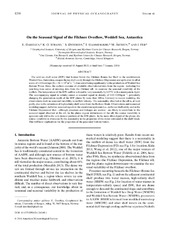| dc.contributor.author | Darelius, Elin Maria K. | |
| dc.contributor.author | Strand, Kjersti Opstad | |
| dc.contributor.author | Østerhus, Svein | |
| dc.contributor.author | Gammelsrød, Tor | |
| dc.contributor.author | Årthun, Marius | |
| dc.contributor.author | Fer, Ilker | |
| dc.date.accessioned | 2016-11-08T07:24:39Z | |
| dc.date.available | 2016-11-08T07:24:39Z | |
| dc.date.issued | 2014 | |
| dc.Published | Journal of Physical Oceanography 2014, 44(4):1230-1243 | eng |
| dc.identifier.issn | 0022-3670 | en_US |
| dc.identifier.uri | https://hdl.handle.net/1956/13069 | |
| dc.description.abstract | The cold ice shelf water (ISW) that formed below the Filchner–Ronne Ice Shelf in the southwestern Weddell Sea, Antarctica, escapes the ice shelf cavity through the Filchner Depression and spills over its sill at a rate of 1.6 Sverdrups (Sv; 1 Sv ≡ 106 m3 s−1), thus contributing significantly to the production of Weddell Sea Bottom Water. Here, the authors examine all available observational data from the region—including five year-long time series of mooring data from the Filchner sill—to examine the seasonal variability of the outflow. The temperature of the ISW outflow is found to vary seasonally by 0.07°C with a maximum in April. The accompanying signal in salinity causes a seasonal signal in density of 0.03–0.04 kg m−3, potentially changing the penetration depth of the ISW plume by more than 500 m. Contrary to recent modeling, the observations show no seasonal variability in outflow velocity. The seasonality observed at the sill is, at least partly, due to the admixture of high-salinity shelf water from the Berkner Bank. Observations and numerical modeling suggest, however, seasonal signals in the circulation upstream (i.e., in the ice shelf cavity and in the Filchner Depression) that—although processes and linkages are unclear—are likely to contribute to the seasonal signal observed at the sill. In the plume region downstream of the sill, the source variability is apparent only within the very densest portions of the ISW plume. In the more diluted part of the plume, the source variability is overcome by the seasonality in the properties of the water entrained at the shelf break. This will have implications for the properties of the generated bottom waters. | en_US |
| dc.language.iso | eng | eng |
| dc.publisher | American Meteorological Society | en_US |
| dc.title | On the seasonal signal of the Filchner overflow, Weddell Sea, Antarctica | en_US |
| dc.type | Peer reviewed | |
| dc.type | Journal article | |
| dc.date.updated | 2016-11-08T07:16:08Z | |
| dc.description.version | publishedVersion | en_US |
| dc.rights.holder | Copyright 2011 American Meteorological Society. Copyright notice: https://www.ametsoc.org/ams/index.cfm/publications/authors/journal-and-bams-authors/author-resources/copyright-information/copyright-policy/ | en_US |
| dc.identifier.doi | https://doi.org/10.1175/jpo-d-13-0180.1 | |
| dc.identifier.cristin | 1149305 | |
